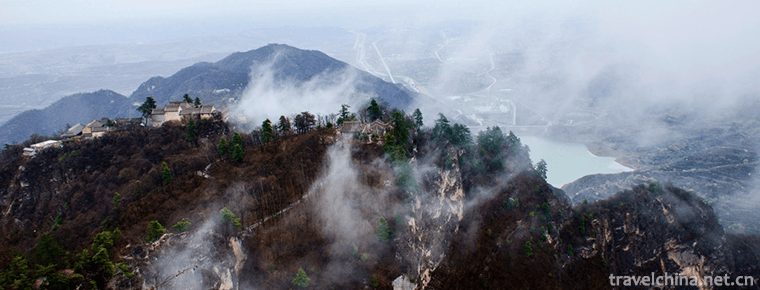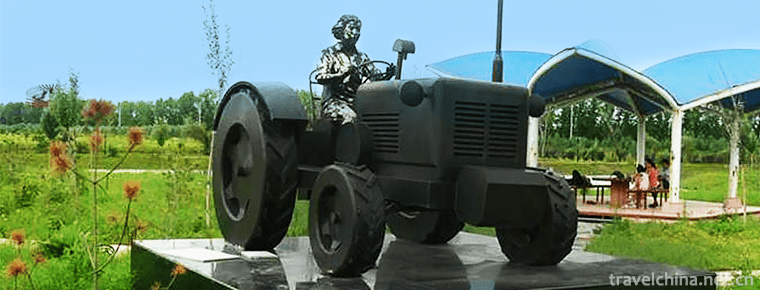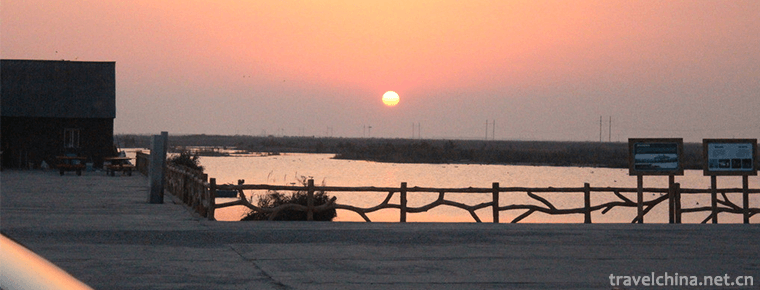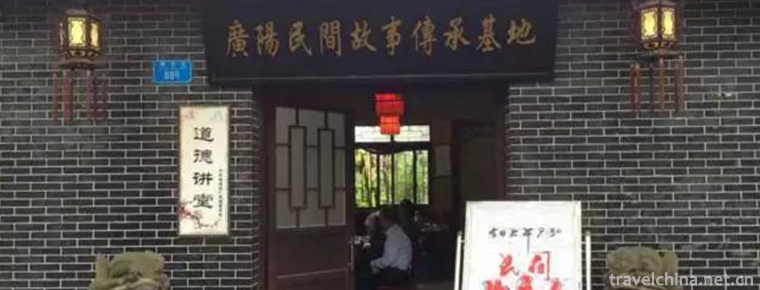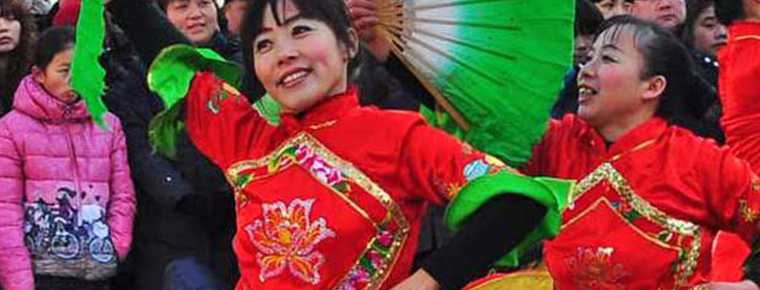Qin Lake National Wetland Park
Qinhu National Wetland Park is located between the central part of Jiangsu Province and the Yangtze and Huaihe River. The total area of the scenic spot is 26 square kilometers. By 2014, the area of the scenic spot open to tourists is 7 square kilometers. Natural resources are superior, and biological types are diverse. There are red-crowned cranes, elk, white swans, white-pillow cranes, white Orioles and so on.
Qinhu Lake Scenic Spot in Qinhu National Wetland Park is a provincial scenic spot approved by Jiangsu Provincial People's Government and a national 5A tourism scenic spot. It is the second national wetland park approved by the State Forestry Administration and the first National Wetland Park in Jiangsu Province.
Location context
Taizhou Qinhu Scenic Area is located in the northwest of Jiangyan District of Taizhou City in the central area of Jiangsu Province. It is within 2 hours'drive from Shanghai, Suzhou, Wuxi, Changzhou, Nanjing, Zhenjiang, Yangzhou, Nantong and other large and medium-sized cities. Ningyan First-class Highway and Jiangqin Highway pass through the area, while Ningjingyan Highway has exits in the scenic area.
topographic features
Scenic lakes, rivers and other areas account for about 37% of the total area, of which Qinhu Lake is a large-scale lake. Qinhu Lake, also known as Magpie Lake, is named for "magpie flying collection in the past". Qinhu Lake is 1.4 kilometers long in East and west, 1.5 kilometers long in South and north. It resembles Yupei. It covers an area of about 3500 mu. There are nine main rivers that reach the lake area in all directions. It naturally forms a strange landscape of "Kowloon Chaoque".
climate
Qinhu wetland belongs to the north subtropical monsoon climate zone, which is the transition zone between subtropical and temperate zones. The climate area is not cold in winter. The average temperature in January is generally above 0 C, and in summer is relatively hot. The average temperature in July is generally about 25 C. The wind direction in winter and summer has obvious changes. The annual precipitation is generally over 1000mm, mainly concentrated in summer and less in winter.
Exploration by Institute of Geographic Sciences and Resources, Chinese Academy of Sciences, Qinhu area is rich in geothermal resources. The scenic spot invested more than 1 million yuan to drill a geothermal well. The outlet water temperature of the well reached 42 C. According to the test and analysis of the National Geological Experiment Center, there are many trace elements in the water which are beneficial to human body. Among them, strontium, metasilicic acid and lithium can meet the national mineral water standard and can be used to make ternary mineral water. Only 10% of mineral water in China is ternary mineral water. Hot springs also have high physiotherapy value.
In 2010, Qinhu Lake Scenic Area firmly promoted the establishment of provincial eco-tourism demonstration areas. In accordance with the requirement of "excellence in landscape, bigger and stronger in management and better in service", 180 million yuan was invested successively, and two wetland restoration projects and water environment control projects were implemented. The total amount of wetland restoration projects was nearly 10,000 mu, and nearly 1 billion yuan was invested in tourism construction. A large number of infrastructure construction of scenic spots were implemented. The only popular science museum with the theme of wetland protection in China has officially opened to the outside world. At the same time, Qinhu Scenic Area invites many domestic first-class design units to revise and improve the overall planning, highlighting the main theme of wetland protection and development. In September 2011, it was officially approved by the State Forestry Administration as the first batch of National Wetland parks.
With the improvement of the ecological environment of Qinhu Lake, Qinhu Wetland has gradually become a haven for birds and wildlife. According to preliminary observation and statistics, there are more than 30 kinds of migratory birds living in Qinhu Lake every year. In order to strengthen the protection of wildlife resources and wetland ecosystem in Qinhu Wetland, Qinhu National Wetland Park has set up relevant ecological monitoring and protection departments.
1. Qinhu National Wetland Park Wetland Protection Office
Responsible for the protection and monitoring of wetland ecological environment, as well as putting forward control measures and carrying out field patrols, and strictly prohibiting activities such as logging and hunting that damage the ecological environment.
(1) Bird Ecological Observation Points in Qinhu Wetland
The biodiversity of wetlands is mainly reflected in the diversity of birds. According to statistics, there are 97 species of birds in Qinhu Lake, including 7 species of state-level protected animals and 6 species of secondary protected animals. The biological characteristics of many birds are not yet clear, and some special research projects require long-term monitoring facilities. To this end, three monitoring sites of bird habits were established in the wetland park.
(2) Qinhu Wetland Hydrological Monitoring Point
Qinhu National Wetland Park cooperates with Jiangyan Environmental Monitoring Station to conduct hydrological monitoring in Qinhu Wetland, which is of great significance for formulating wetland management and protection measures. According to the present situation of Qinhu wetland entering and retreating, there are three hydrological monitoring points in the estuaries of Jiangqin River and Taidong River.
(3) Qinhu Wetland Meteorological Observation Point
Observation of wetland meteorological factors is of great significance to the analysis of wetland climate change and hydrological data. In cooperation with Nanjing Forestry University, Qinhu National Wetland Park established Qinhu Wetland Meteorological Observation Point to monitor and study the climate and meteorology of Qinhu Wetland.
2. Qinhu Wetland National Wildlife Focus Disease Monitoring Station
A National Wildlife epidemic surveillance station has been set up in Qinhu wetland. The equipments for wildlife observation and animal sample extraction have been equipped to strengthen the surveillance and control of migratory birds and wildlife epidemic diseases. Through the direct reporting system of wildlife epidemic foci and diseases, the monitoring situation can be reported to the National Wildlife Protection Station in time.
3. Wildlife Rescue Center of Qinhu National Wetland Park
In order to strengthen the protection of wildlife and the rescue of injured animals in Qinhu Wetland, a wildlife rescue center was established in Qinhu National Wetland Park. Meanwhile, Qinhu Wetland Wildlife Rescue Center is the only one in Taizhou. Every year, the Qinhu Wetland Wildlife Rescue Center rescues many wildlife brought by the masses.
Boat Festival
The annual "China Qintong Shipping Festival" is deduced on Qinhu Lake. The Qintong Shipping Festival is a unique custom deduced from a tragic historical story. Every year in the Qingming Dynasty, on the vast lake, gongs and drums are noisy, bamboo poles stand in the sky, and all kinds of flower boats, dragon boats and boats are racing in a thousand boats. Its magnificent scenes, thrilling competitions and colorful performances can be called the Grand View of folk culture and the exhibition of watery customs. The media at home and abroad are known as "the number of ships in the world is Qintong". Qintong Boat Festival and Yunnan Water Sprinkling Festival are listed as the top ten national folk festivals. They are also the key projects of Jiangsu, Zhejiang and Shanghai Tourism Festivals and the only national tourism projects in Taizhou. Every year from around the Qingming Dynasty to May, Qinhu Lake in Jiangyan, Jiangsu Province, holds a large-scale "Qintong Shipping Festival". This custom of "meeting boats" from Ming Dynasty to the present has become the local custom and characteristic culture. Since ancient times, there has been the saying that "the number of ships under heaven will be Qintong".
Religious culture
The religious culture of Lixia River is also a bright page of Chinese religious culture. The ancient Shousheng Temple was built in the Song Dynasty. It has a history of more than 700 years. It is one of the "fourteen jungles" in Buddhism. Moreover, it is also a place where culture and history converge. Shuiyun Tower, the famous Tibetan Sutra Building behind Daxiong Palace, has attracted many literati and poets to stay in seclusion for thousands of years, such as the Ming official's waiter tank, Zheng Banqiao, the veteran of the Republic of China Yu Youren and so on.










-
Ailao Mountain
Ailao Mountain, located in the middle of Yunnan Province, China, extends south of Yunling Mountains. It is the boundary between Yunnan-Guizhou Plateau and Hengduan Mountains. It is also the watershed .
Views: 440 Time 2018-11-01 -
Kongtong Mountain Scenic Spot
Kongtongshan Scenic Area is located 12 kilometers west of Pingliang City, Gansu Province. It overlooks Xi'an in the east, Lanzhou in the west, Baoji in the South and Yinchuan in the north.
Views: 209 Time 2018-12-12 -
The Great Northern Wilderness Agricultural Expo
Beidahuang Agricultural Machinery Expo Park is a national AAAA-level tourist attraction located in Youyi County, 50 kilometers away from the city center, covering an area of 350,000 square meters..
Views: 175 Time 2018-12-26 -
Yellow River Estuary Ecotourism Area
The Yellow River Estuary Ecotourism Area is located in the Yellow River estuary area of Dongying City, Shandong Province. It has unique ecotourism resources of the Yellow River Delta.
Views: 151 Time 2019-01-18 -
Definite day harmonics
Dingriluo Harmony Dingriluo Harmony, the second batch of national intangible cultural heritage list of the People's Republic of China. It is the main form of folk singing and dancing in Dingri County.
Views: 184 Time 2019-04-27 -
Folk Stories in Guangyang Town
"Guangyang Folk Stories" is the general name of folklores and stories widely spread in Guangyang Town. Guangyang folk tales are popular in the local area..
Views: 188 Time 2019-05-01 -
Jingxing spent
Jinglonglahua, a traditional dance in Jinglongxian County, Hebei Province, is one of the national intangible cultural heritage..
Views: 347 Time 2019-05-08 -
Legend of Liu Ruan
The legend of Liu Ruan, also known as the story of Liu Ruan's encounter with immortals, is spread in Shangxian (now Xinchang, Shengzhou) and Tiantai. It is a mythological love story that takes Liu Rua.
Views: 388 Time 2019-05-13 -
Beijing Institute Of Graphic Communication
Beijing Printing College is a full-time general higher education institution established by the Beijing Municipal People's Government and the former General Administration of Press and Publication. Th.
Views: 164 Time 2019-09-22 -
Yinghua mountain
Yinghua mountain is located 37 kilometers northwest of Shifang City, Deyang City, Sichuan Province, 98 kilometers away from Chengdu. In 1986, it was designated as the first batch of provincial-level scenic spots, with a landscape area of 106 square kilometers..
Views: 176 Time 2020-11-05 -
Leshan social service
By the end of 2018, there were 13 social welfare homes in Leshan City with 2908 beds and 2182 people in the hospital. The sales of social welfare lottery tickets totaled 385.69 million yuan, raised 109.75 million yuan of welfare lottery public welfare fund,.
Views: 163 Time 2020-12-17 -
Meishan Sports
In 2019, 45 games will be held and 30000 people will participate in the games. At the end of the year, there were 116 sports associations. By the end of the year, there were 1410 sports venues in the education system. Meishan post and telecommunication.
Views: 359 Time 2020-12-18

